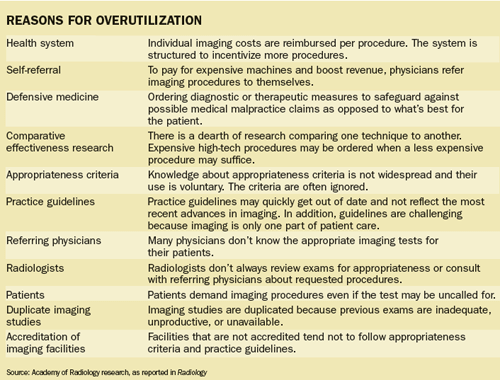In overutilization, some practices more culpable
Nothing gets a radiologist's blood boiling quicker than the word “overutilization.
Nothing gets a radiologist's blood boiling quicker than the word “overutilization.” Clearly overutilization is a touchy subject-just look at the three pages of comments on Diagnostic Imaging’s website in response to a recent poll question-but that doesn't mean some areas of radiology don’t contribute more than others. The top three culprits for overutilization are defensive medicine, the emergency room, and self-referral, according to the president of the American College of Radiology.

In a Radiology article published online ahead of print, Dr. James Thrall, ACR president, and colleagues laid out reasons why overutilization occurs and what can be done about each area (see chart). The biggest culprit of all is the practice of defensive medicine, which overlaps with the attitudes found in the emergency department.
Defensive medicine, the ordering of diagnostic or therapeutic measures to safeguard against medical malpractice claims, accounted for 25% of high-tech imaging studies in Massachusetts, which came to about $1.4 billion per year, according to a study on the Massachusetts Medical Society’s website (Radiol doi: 10.1148/radiol.10100063).
“Defensive medicine is, without question, an enormous cost to the healthcare system,” said Thrall, also a professor of radiology at Harvard. “Tort reform would go a long way toward reducing healthcare costs. And, in fact, in work I’ve published in my columns as chair of ACR [board of chancellors], I estimated that defensive medicine costs the country between $100 billion and $200 billion a year.”
Since healthcare reform is estimated to cost $1 trillion over 10 years, if lawmakers addressed tort reform, it would be free, he said.
Along with the threat of a malpractice lawsuit, emergency department physicians must contend with the Emergency Medical Treatment and Active Labor Act (EMTALA), a law designed to prevent hospitals from transferring patients they do not want to care for. It requires emergency physicians and hospitals to thoroughly evaluate any patient who comes to the emergency department, which may in turn lead to overutilization.
“I’m told that the fine for violating EMTALA is $25,000 per incident,” Thrall said. “So not only are emergency department physicians paranoid about being sued, they are paranoid about not obeying EMTALA.”
An emergency radiologist agrees with Thrall’s assessments.
“There is tremendous overutilization of imaging from the emergency department,” said Dr. Stu Mirvis, a professor of diagnostic radiology and nuclear medicine at the University of Maryland. “As one example among many, it does not take much in the way of symptoms to get a CT scan requested from the emergency department.”
Any shortness of breath or unexplained source of chest pain becomes an indication for a pulmonary CT angiogram, he said. Even in patients for whom something such as pneumonia accounts for their symptoms, the rule-out pulmonary embolism exam is still considered appropriate.
If scientifically well established, widely supported clinical guidelines are acted on appropriately in medical decision-making, the physician should be protected no matter what the medical outcome, Mirvis said.
“The sense that you can be sued and spend five years-or more-defending yourself because something may be missed has certainly fueled the use of ‘protect your butt’ imaging,” he said.
No doubt defensive medicine (and thus the emergency department) accounts for much overutilization, but the third major culprit is self-referral.
“The self-referral doctors who own their own imaging equipment leading to overutilization, that story is solid; it’s so embarrassing to the medical profession,” Thrall said. “It’s hard to know what else to say.”
Several studies have shown self-referral leads to overutilization, including one by Drs. David Levin and Vijay Rao, who estimated self-referral costs $16 billion a year in unnecessary imaging procedures in the U.S. (J Am Coll Radiol 2004;1[3]:169-172).
“The thing that’s interesting about this problem of overutilization is that we actually more or less know how to fix the problem,” Thrall said. “But do we have the political will in the U.S. to address it?”
The answer to that question seems to be “No.” Congress backed down on a measure to address self-referral in the healthcare reform legislation because they were flooded with phone calls, and tort reform seems unlikely.
While it’s a small piece of the pie, what can be done to address overutilization is educating referring physicians and patients, using clinical decision-support tools, and following appropriateness criteria as well as practice guidelines, Thrall said.
GE HealthCare Debuts AI-Powered Cardiac CT Device at ACC Conference
April 1st 2025Featuring enhanced low-dose image quality with motion-free images, the Revolution Vibe CT system reportedly facilitates improved diagnostic clarity for patients with conditions ranging from in-stent restenosis to atrial fibrillation.
The Reading Room Podcast: Current Perspectives on the Updated Appropriate Use Criteria for Brain PET
March 18th 2025In a new podcast, Satoshi Minoshima, M.D., Ph.D., and James Williams, Ph.D., share their insights on the recently updated appropriate use criteria for amyloid PET and tau PET in patients with mild cognitive impairment.